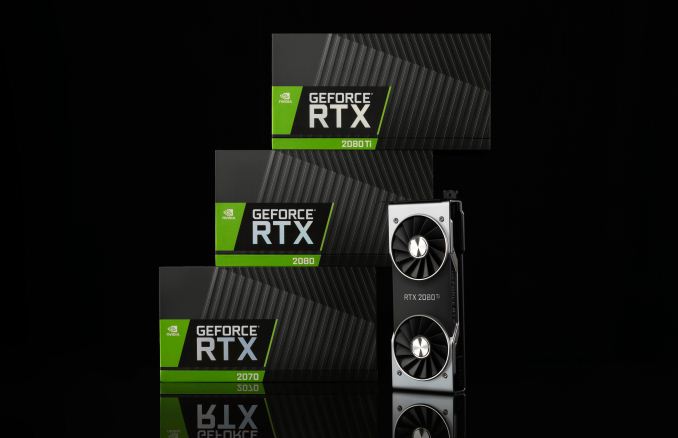The NVIDIA Turing GPU Architecture Deep Dive: Prelude to GeForce RTX
by Nate Oh on September 14, 2018 12:30 PM ESTClosing Thoughts
With a tagline like ‘Graphics Reinvented’, NVIDIA is certainly not straying from putting Turing in the most revolutionary limelight as possible. In that sense, NVIDIA is choosing to compare Turing to Pascal rather than Volta for every possible circumstance, especially for gaming. This decision is certainly not unfounded because for consumers, the Turing-based GeForce 20-series succeeds the Pascal-based GeForce 10-series. However, this can give the impression that because Turing is so different from Pascal, it warrants dissimilar comparisons like RTX-OPS metrics or gaming performance uplifts with DLSS or raytracing enabled.
The situation becomes a little more muddled because of several reasons:
- The pricing and availability of the RTX 20-series means that on a purely market segmentation level, it does not directly replace Pascal gaming products
- As gaming-focused cards, the major new features (RT cores, tensor cores, advanced shading) of the RTX 20-series do not operate out-of-the-box in games, are specific to select games, and
- The burden of communication is on the developers to educate consumers on the details of specific raytracing effects or use of AI-accelerated denoisers
These aren’t points that necessarily need to define Turing, except that NVIDIA has pushed the envelope by going all-in with marketing and branding. For their part, NVIDIA will have an continously updated list of games with RTX platform support.
On one hand, Turing seems like a possible solution to the gaming/compute architecture divergence. It seems less likely now that NVIDIA would backtrack into a more standard design for maximum rasterization performance, though obviously that remains to be seen with how the product fares. In any case, as most silicon design firms hvae leapfrogging design teams, the major decisions are likely not to move too far to the fixed function side, if only because the greatest strength of GPUs in compute is its programmability and versatility.
Looking back at ray tracing, it seems that even if it isn't immediately practical, there would still be a seeding effect to be gained via enthusiasts and certain gamers, which would work well with higher-profile AAA games. As we move into next week, it appears that the GeForce RTX 20-series is definitely one of the more nuanced graphics products, with both caveats and potential.

















111 Comments
View All Comments
gglaw - Saturday, September 15, 2018 - link
Why bother to make up statements claiming the prices are completely as expected with inflation added without even having a slight clue what the inflation rate has been in recent history? Outside of the very young readers here, most of us were around for 700 series, 8800, etc. and know first hand what type of changes inflation has had in the last 10-20 years. Especially comparing to the 980 Ti, and 1080 Ti, inflation has barely moved since those releases.Spunjji - Monday, September 17, 2018 - link
This. Most people here aren't stupid.notashill - Saturday, September 15, 2018 - link
700 series wasn't even close. 780 was $650->adjusted ~$700, 780Ti was $700->adjusted ~$760. And the 780 MSRP dropped to $500 after 6 months when the Ti launched.Santoval - Monday, September 17, 2018 - link
Yes, Navi will be midrange, at around a GTX 1080 performance level, or at best a bit faster. They initially planned a dual Navi package for the high end, linked by Infinity Fabric, but they canned (or postponed) it, due to the reluctance of game developers to support dual-die consumer graphics cards (according to AMD). They might release dual Navi professional graphics cards though.Tensor and RT cores should not be expected either. These will have to wait for the post-Navi (and post-GCN) generation.
TropicMike - Friday, September 14, 2018 - link
Good article. Lots of complicated stuff to try to explain.Just a quick typo on page 2: "It’s in pixel shaders that the various forms of lighting (shadows, reflection, reflection, etc) " I'm guessing you meant 'refraction' for one of those.
Smell This - Wednesday, July 3, 2019 - link
Super **Duper** Turbo Hyper Championship EditionYaldabaoth - Friday, September 14, 2018 - link
For the "eye diagram" on page 8, the texts says, "In this case we’re looking at a fairly clean eye diagram, illustrating the very tight 70ns transitions between data transfers." However, the image is labeled as "70 ps".Ryan Smith - Friday, September 14, 2018 - link
Nano. Pico. Really, it's a small difference... =PThanks!
Bulat Ziganshin - Friday, September 14, 2018 - link
It's not "Volta in spirit". It's Volta for the masses. The only differences- reduced FP64 cores
- reduced sharedmem/cache from 128 KB to 96 KB
- added RT cores
Now let's check what you want to change to produce "scientific" Turing GPU. Yes, exactly these things. So, despite the name, it's the same architecture, tuned for the gaming market
Yojimbo - Saturday, September 15, 2018 - link
You don't really know that. This article, as explained in the beginning, focuses only on the RT core improvements. There are other Turing features that were left out. I think we have no idea if Volta has variable rate shading, mesh shading,or multi-view rendering. I'm guessing it does not.Besides, what you said isn't true even limiting the discussion to what was covered in this article. The Turing Tensor cores allow for a greater range of precisions.